Papers by Elsiddig Elsheikh
Saudi Journal of Biological Sciences
Maǧallaẗ ǧāmi’aẗ al-H̲arṭūm li-l-’ulūm al-zirā’iyyaẗ, Mar 28, 2023
Antibiotics, Aug 11, 2022
This article is an open access article distributed under the terms and conditions of the Creative... more This article is an open access article distributed under the terms and conditions of the Creative Commons Attribution (CC BY
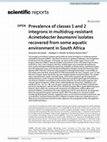
Scientific Reports, Nov 24, 2022
The emergence of antibiotic-resistance genes (ARGs) by means of integrons in multidrug-resistant ... more The emergence of antibiotic-resistance genes (ARGs) by means of integrons in multidrug-resistant Acinetobacter baumannii (MDR A. baumannii) has become a significant challenge in the management of infections from this pathogen. In this paper, we report on the variable region of class 1 and 2 integrons observed in MDR A. baumanni isolates recovered from rivers in the Eastern Cape Province, South Africa. Class 1 and 2 integrons with their variable regions were evaluated with polymerase chain reaction techniques followed by sequencing. Antibiotic sensitivity testing, checkerboard assay, time-kill independent assay, and Enterobacterial Repetitive Intergenic Consensus Polymerase Chain Reaction (ERIC-PCR) were carried out using standard microbiological techniques. A total of fifty-six (56) isolates were examined, among which 45 (79%) tested positive for class 1 integron, and 7 (12.3%) had class 2 integron. None was found to be class 3 integron positive among the isolates. The variable region contained aadA1, aadA5, and aadA2 genes, which confer resistance against streptomycin and spectinomycin, aac(6′)-Ib against amikacin/ tobramycin and dfrA17 genes against trimethoprim. The minimum inhibitory concentrations of the antimicrobials for one of the tested organisms were resistant against meropenem, colistin sodium methanesulfonate, tetracycline, ceftazidime, and ciprofloxacin (16, > 16, > 8, > 256, and 128 ug/mL respectively). The impact of colistin combined with quinolones (ciprofloxacin), with the FICIs (0.31) indicated synergistic effects against MDR A baumanni. However, when colistin was combined with meropenem and ceftazidime, additive effects with fractional inhibitory concentration (FIC) index ranging from 0.52 to 1 were observed. No antagonistic effect was evaluated among the examined isolates. ERIC-PCR analyses of A. baumanni isolates revealed significant genetic diversity, suggesting various sources of environmental contamination. We conclude that A. baumanni harbouring class 1 integrons in aquatic milieus are a significant source of ARGs and can transmit these elements to other organisms and consequently to man with significant public health implications. A. baumannii is an important aerobic Gram-negative opportunistic hospital-acquired infections (HAIs) pathogen with wide dissemination in the environment 1. It is responsible for the diversity of HAIs such as urinary tract infections, ventilator associated pneumonia, bacteraemia, secondary meningitis, surgical-site infections 2,3 , burn wound and soft tissue specifically in the intensive care unit (ICU), and burn units 4. A. baumannii was listed with the six highest priority pathogenic drug-resistant organisms by the Infectious Diseases Society of America 5 , as its occurrence is becoming a cause for concern globally 6. Due to the acquisition of a large spectrum of ARGs coupled with environmental adaptation in various harsh conditions by A. baumannii, the pathogen is becoming a clinical serious concern 7. Over the past years, despite novel therapeutic alternatives, A. baumannii strains have demonstrated a huge capacity for the speedy growth of multidrug resistance. The increase is not only a result of the intrinsic resistant genes borne by these species but also of their remarkable ability to obtain resistant
Arab journal of basic and applied sciences, Apr 9, 2023
Pesticide Research Journal, 2020

Applied Biological Chemistry, 2017
Biodegradation of endosulfan (a and b) and pendimethalin by Bacillus safensis strain FO-36b T , B... more Biodegradation of endosulfan (a and b) and pendimethalin by Bacillus safensis strain FO-36b T , Bacillus subtilis subsp. inaquosorum strain KCTC 13429 T and Bacillus cereus strain ATCC14579 T isolated from pesticides-polluted soil was studied in mineral salt medium. Endosulfan and pendimethalin were incubated with the three bacterial strains with samples drawn at various intervals for GC analysis. Representative samples were subject to GC-MS analysis. The loss in the initial concentrations, 0.663 mM (a endosulfan), 0.319 mM (b endosulfan) and 1.423 mM (pendimethalin), was monitored and used to compute the half-lives following biphasic model. Removal percentage of endosulfan and pendimethalin in the media inoculated with the bacterial strains ranged from 24 to 95% (a endosulfan), 21-91% (b endosulfan) and 51-97% (pendimethalin), respectively. Despite the significant decrease in starting material in B. safensis cultures, no metabolites were detected, whereas two major metabolites of endosulfan, 1,2,3,4,7,7-hexachloro-5,6-dihydroxybicyclo{2.2.1}-2-heptene and 1,2,3,4,7,7-hexachloro-formaldehyde-6-methylbicyclo{2.2.1}-2-heptene, were detected in the B. subtilis cultures, and one metabolite of pendimethalin metabolite; N-(1-ethylpropyl)-3-methyl-2, 6-diaminobenzine, was detected in the B. cereus culture. Generally, the result indicates the potential capability of these microorganisms in complete mineralization of endosulfan and pendimethalin. Based on half-lives, the efficiency of bacterial strains can be ordered as follows: B. subtilis [ B. cereus [ B. safensis for endosulfan and B. cereus [ B. safensis [ B. subtilis for pendimethalin.
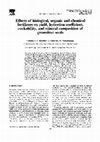
Food Chemistry, 1998
A field experiment was carried out to investigate the effects of Bradyrhizobium, VA Mycorrhizal i... more A field experiment was carried out to investigate the effects of Bradyrhizobium, VA Mycorrhizal inoculation, phosphorus, nitrogen and chicken manure on yield, loo-seed weight, cookability, hydration coefficient and mineral composition of groundnut (Arachis hypogaea) seeds. The results showed that nitrogen, phosphorus and chicken manure treatments significantly (p<O.OOl) increased yield, loo-seed weight, non-soakers, and hydration coefficient, in the absence of Bradyrhizobium and/or VA mycorrhizal inoculation. The results also showed that Bradyrhizobium and/or VA mycorrhizal inoculation significantly (p<O.OS) increased yield, loo-seed weight, cookability, hydration coefficient, P, Na, K, Cu and Mg contents. A positive correlation (r = 0.874.94) was observed between the hydration coefficient and cookability. Na, K and Cu content of seeds were significantly (~50.05) increased with N, P and manure treatments, whereas, the Mg percentage increased by N and P treatments and decreased when 0.01 mton manure were applied. The results of this investigation indicate that Bradyrhizobium and mycorrhizal inoculation are promising biological fertilizers because they are cheap, easy to handle and improve groundnut growth, yield and seed quality.
Annals of Applied Biology, 1998
A field experiment was carried out to investigate the effect of Bradyrhizobium and mycorrhizal (G... more A field experiment was carried out to investigate the effect of Bradyrhizobium and mycorrhizal (Glomus sp.) inoculation compared to adding urea and super phosphate on proximate composition, in vitro protein digestibility (IVPD) and tannin content of groundnut. The results showed that mycorrhizal inoculation and/ or superphosphate significantly (P 5 0.05) increased both oil and protein content of groundnut seeds. Bradyrhizobium and/or nitrogen fertiliser significantly (P 5 0.05) increased protein content and significantly decreased the oil content. Bradyrhizobium and/or mycorrhizal inoculation significantly (P 5 0.05) increased the ash, crude fibre, IVPD and tannin content. Biological and chemical fertilisers significantly (P 5 0.05) increased IVPD. Superphosphate fertilisers significantly
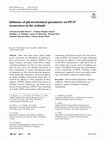
Environmental Monitoring and Assessment
There have been many global studies on the occurrence and distribution of pharmaceuticals and per... more There have been many global studies on the occurrence and distribution of pharmaceuticals and personal care products (PPCPs) in the aquatic resources, but reports on the effects of physicochemical properties of water on their concentrations are very scarce. The amounts and removal of these contaminants in various environmental media are dependent on these physicochemical properties, which include pH, temperature, electrical conductivity, salinity, turbidity, and dissolved oxygen. Here, we reviewed the influence of these properties on determination of PPCPs. Reports showed that increase in turbidity, electrical conductivity, and salinity gives increase in concentrations of PPCPs. Also, neutral pH gives higher PPCP concentrations, while decrease in temperature and dissolved oxygen gives low concentration of PPCPs. Nevertheless, it is quite challenging to ascertain the influence of water quality parameters on the PPCP concentration, as other factors like climate change, type of water, ...
University of Khartoum Journal of Agricultural Sciences, 2008
... Andera S. Mohammed, Siddig M. El Hassan, Mustafa MA Elballa 1 and Elsiddig AE Elsheikh 2 ... ... more ... Andera S. Mohammed, Siddig M. El Hassan, Mustafa MA Elballa 1 and Elsiddig AE Elsheikh 2 ... Treatment No. of stems/pot Plant height (cm) Non-infested soil Infested soil Mean Non-infested soil Infested soil Mean Control (untreated) 6.33a 3.33a 4.63cd 57.83d 13.66g 35.75c ...

International journal of Sudan research, Jan 15, 2014
The aim of this study was to investigate the effect of organic chemical and microbial fertilizers... more The aim of this study was to investigate the effect of organic chemical and microbial fertilizers on the growth of groundnut and faba bean grown in three types of soils. Design/methodology/approach: Two pot experiments were conducted at the nursery of the Faculty of Agriculture, University of Khartoum during the summer of 2009 and winter 2009-2010. The treatments were arranged in a completely randomized design with three replications. Chicken manure, manufactured organic fertilizers (Elkhaseeb, Elkhairat and Abu floos), Effective Microorganisms (EM), Rhizobium and urea were used in three soil types (Shambat, Elrawakeeb and Gerif). Chicken manure and manufactured organic fertilizers were applied at the rate equivalent to 40 Kg N/ha and urea was applied at the rate of 40 Kg N/ha. Data were collected on the number of nodules, plant height, dry weight of shoots and roots at ten weeks after sowing. The nitrogen, phosphorus and potassium content of shoots were determined at ten weeks after sowing.
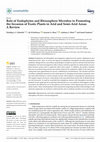
Sustainability, 2021
Endophytes and rhizospheric microorganisms support invasive species’ adaptation to environmental ... more Endophytes and rhizospheric microorganisms support invasive species’ adaptation to environmental stresses. Here, we review the impacts of endophytes, rhizospheric microbes (particularly symbiotic nitrogen-fixers), mycorrhiza and pathogens on plant invasion in arid and semi-arid areas. Endophytes and soil microorganisms either enhance nutrient acquisition for enhancing the invasive plant immune system and/or negatively affect native plants. In addition, the positive feedback between mycorrhizal fungi and invasive plants enhances the competitive ability of the aliens, providing them more opportunities for success, establishment, and dominance. The microbes and their secondary metabolites promote invasive plant species by changing soil microbial community structure and carbon biomass as well as enzyme activity, which improves soil properties and processes. The negative impact of invasive exotic plants on the associated biota and the role of allelochemicals are also discussed. It could ...
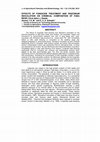
Journal of Agricultural Chemistry and Biotechnology, 2010
The effects of fungicidal seed dressing and Rhizobium inoculation on the chemical properties of f... more The effects of fungicidal seed dressing and Rhizobium inoculation on the chemical properties of faba bean seeds were studied. Two fungicides, Captan and Fernasan-D at concentrations between zero and 10 g/kg seeds were used. Inoculation with Rhizobium leguminosorum bv. viceae strain TAL 1397 immediately before or after seed dressing or inoculation at the seedling stage was adopted.Compaired to uninoculated plants, Rhizobium inoculation by both methods significantly (P≤0.01) increased seed moisture content, fat content, fibre and protein content. Carbohydrate content was significantly (P≤0.01) decreased while no effect was detected on ash content. No clear differences were observed between inoculation immediately before or after seed dressing (First season). Fungicide seed dressing significantly (P≤0.01) increased ash, moisture and carbohydrate contents when applied at the field recommended dose. Fat, fibre and protein contents were significantly (P≤0.01) decreased with different degrees depending on fungicide toxicity and concentration. Increasing the concentration of both fungicides resulted in lower contents of fat, fibre and protein contents. No differences between the two fungicides were observed in the contents of moisture, ash and crude fibre. Captan seed dressing resulted in lower fat and crude protein content and higher carbohydrates content compared to Fernasan-D.
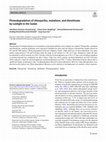
Environmental Earth Sciences, 2019
The potential of sunlight photolysis in remediation of pesticide-polluted soils in Sudan was stud... more The potential of sunlight photolysis in remediation of pesticide-polluted soils in Sudan was studied. Chlorpyrifos, malathion and dimethoate, common pollutants, were exposed to sunlight over glass and soil surfaces with periodic samples drawn for GC and GC-MS analysis. Photo-degradation followed a biphasic model. Alpha half-lives of direct photolysis over glass surface range between 1.99 and 9.36 days while the range in soil surfaces is 1.88-10.77 days. Respective values for indirect photolysis with β-carotene are 0.96-2.40 days whereas for benzophenone are 0.38-2.37 days (not including malathion as starting material was completely lost after 3 days). Values for soil β-carotene sensitized photolysis are 0.85-4.02 days while respective values for soil benzophenone sensitized photolysis are 0.88-3.74 days. Metrological factors did not have a significant impact on photolysis rates. No photoproducts detected in direct photolysis. However, many photoproducts were detected on the indirect sets. Photo-degradation efficiency can be ordered as; benzophenone > β-carotene > direct exposure.

Journal of Agricultural and Food Chemistry, 2016
This study was done to identify pesticide-biodegrading microorganisms and to characterize degrada... more This study was done to identify pesticide-biodegrading microorganisms and to characterize degradation rates. Bacillus safensis strain FO-36b(T), Bacillus subtilis subsp. inaquosorum strain KCTC13429(T), and Bacillus cereus strain ATCC14579(T) were isolated from pesticide-polluted soil in Sudan, separately incubated with each pesticide with periodic samples drawn for GC and GC-MS. Pesticide biodegradation followed a biphasic model. α and β half-lives (days) of chlorpyrifos, malathion, and dimethoate in B. safensis culture were 2.13, 4.76; 2.59, 5.66; and 9.5, 11.0, respectively. Values in B. subtilis and B. cereus cultures were 4.09, 9.45 and 4.33, 9.99 for chlorpyrifos; 2.99, 5.36 and 2.43, 4.71 for malathion; and 9.53, 15.11 and 4.16, 9.27 for dimethoate. No metabolite was detected in B. subtilis cultures, whereas a few were detected from B. safensis and B. cereus cultures. Bacterial efficiency can be ordered as B. safensis &amp;amp;amp;amp;amp;amp;amp;amp;amp;amp;amp;amp;amp;amp;amp;amp;amp;amp;amp;amp;amp;amp;amp;amp;amp;amp;amp;amp;amp;amp;amp;amp;amp;amp;amp;amp;amp;amp;amp;amp;amp;amp;amp;amp;amp;amp;amp;amp;amp;amp;amp;amp;amp;amp;amp;amp;amp;amp;amp;amp;amp;amp;amp;amp;amp;amp;gt; B. subtilis &amp;amp;amp;amp;amp;amp;amp;amp;amp;amp;amp;amp;amp;amp;amp;amp;amp;amp;amp;amp;amp;amp;amp;amp;amp;amp;amp;amp;amp;amp;amp;amp;amp;amp;amp;amp;amp;amp;amp;amp;amp;amp;amp;amp;amp;amp;amp;amp;amp;amp;amp;amp;amp;amp;amp;amp;amp;amp;amp;amp;amp;amp;amp;amp;amp;amp;gt; B. cereus for chlorpyrifos and B. cereus &amp;amp;amp;amp;amp;amp;amp;amp;amp;amp;amp;amp;amp;amp;amp;amp;amp;amp;amp;amp;amp;amp;amp;amp;amp;amp;amp;amp;amp;amp;amp;amp;amp;amp;amp;amp;amp;amp;amp;amp;amp;amp;amp;amp;amp;amp;amp;amp;amp;amp;amp;amp;amp;amp;amp;amp;amp;amp;amp;amp;amp;amp;amp;amp;amp;amp;gt; B. subtilis &amp;amp;amp;amp;amp;amp;amp;amp;amp;amp;amp;amp;amp;amp;amp;amp;amp;amp;amp;amp;amp;amp;amp;amp;amp;amp;amp;amp;amp;amp;amp;amp;amp;amp;amp;amp;amp;amp;amp;amp;amp;amp;amp;amp;amp;amp;amp;amp;amp;amp;amp;amp;amp;amp;amp;amp;amp;amp;amp;amp;amp;amp;amp;amp;amp;amp;gt; B. safensis for malathion and dimethoate.











Uploads
Papers by Elsiddig Elsheikh